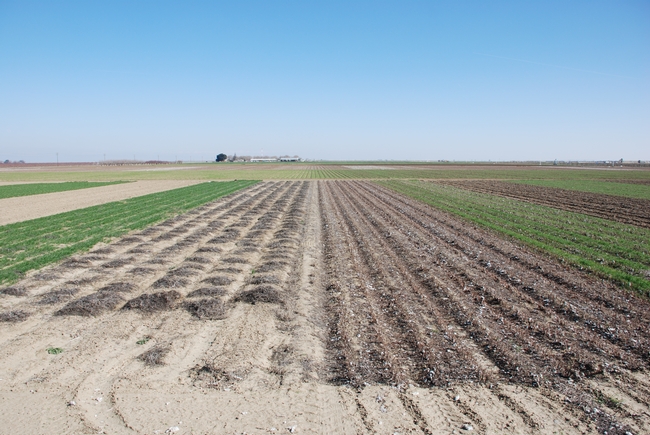Even on the west side of the San Joaquin Valley, where average rainfall is a mere 7 inches per year, farmers can reap the benefits of winter cover crops without the expense of irrigation, University of California research has found. Growing a winter cover crop helps retain soil nitrogen – keeping it from leaching into groundwater – improves water infiltration, reduces runoff, increases soil organic matter and boosts long-term soil fertility.
Moreover, a vigorously growing cover crop can smother winter weeds, reducing or eliminating the need for herbicides or tillage between crops.
“Despite the many and varied benefits of cover cropping that are increasingly seen by farmers in other parts of the country, the vast majority of Central Valley farmers currently do not use them,” said Jeff Mitchell, UC Cooperative Extension specialist in the Department of Plant Sciences at UC Davis. Mitchell, a cropping systems expert, is based at the Kearney Agricultural Research and Extension Center in Parlier, Calif.
The costs and benefits of winter cover crops are being examined in an ongoing trial at the UC West Side Research and Extension Center in Five Points, Calif. Initiated in 2000, the trial is led by Mitchell, William Horwath, a professor in the Department of Land, Air and Water Resources at UC Davis, and Dan Munk, UC Cooperative Extension advisor in Fresno County, a cotton and soils expert.
Mitchell said the West Side trial addresses valley farmers’ primary concern about cover crops – water.
“When water is short, as it has been in many recent years, farmers wonder how inserting an extra crop that doesn’t bring an immediate return on investment makes sense,” Mitchell said. “But our work over the last 12 years has demonstrated that cover cropping ‘on the cheap’ – relying only on rainfall for irrigation – supplies many benefits and doesn’t cost much.”
Rainfall during the November to March winter growth period in Five Points averages 7 inches, slightly less than the 30-year average annual rainfall of 7.6 inches for the site. Winter rainfall has varied considerably during the trial, from a low of 2.9 inches in 2003 to a high of 11 inches in 2006.
From 2000 to 2010, a cover crop mix of triticale, ryegrain and pea was grown at a seed cost of $55 per acre (2012 dollars). In 2011 and 2012, the researchers used a mixture of fava bean and “tillage radish” for the cover crop, at a cost of $50 per acre.
Tillage radish is a large-rooted winter annual being marketed for its ability to improve soil condition. It’s thick, tuberous roots break up the soil surface. When it is killed in the spring and the roots decompose and shrivel, it leaves behind channels that help with aeration and water infiltration.
Over the course of the UC trial, an average of 3,400 pounds of dry biomass per acre was produced by the cover crops each year with rainfall alone. Productivity generally related to the amount of rain, with as little as 65 pounds of dry biomass per acre in 2007, when rainfall was 5.2 inches, and 6,400 pounds in 2005, when 10.1 inches of rain fell.
The timing of rainfall was also important. Rain is needed early to establish the crop and late in the season to sustain its growth when the temperature warms.
Over time, growing cover crops results in a significantly higher amount of carbon in the top foot of soil. Following eight years of cover cropping, soil carbon values in the standard tillage cover crop system, in which the cover crop was treated as a green manure and incorporated into the soil at a depth of 10 inches, was 12.2 tons of carbon per acre. Where cover crops were combined with conservation tillage, the researchers measured 12.8 tons per acre. In areas managed with conservation tillage and no cover crop, 11.7 tons per acre of carbon was in the top foot of soil. Under standard tillage and no cover crops, currently the common practice in the San Joaquin Valley, soil carbon came in at 9.9 tons per acre.
In addition to improving soil quality, farmers are investigating whether storing extra carbon in the soil will make them eligible for selling carbon credits under California Assembly Bill 32, the Global Warming Solutions Act.
“Sequestering carbon in farmland could be a means of mitigating global warming from greenhouse gas emissions,” Mitchell said. “We are working with farmers to develop a record of performance so they can document their potential for storing more carbon using conservation tillage and cover crops.”
Attached Images:

Experimental field in which conservation tillage with and without cover crops are being compared to standard tillage systems.